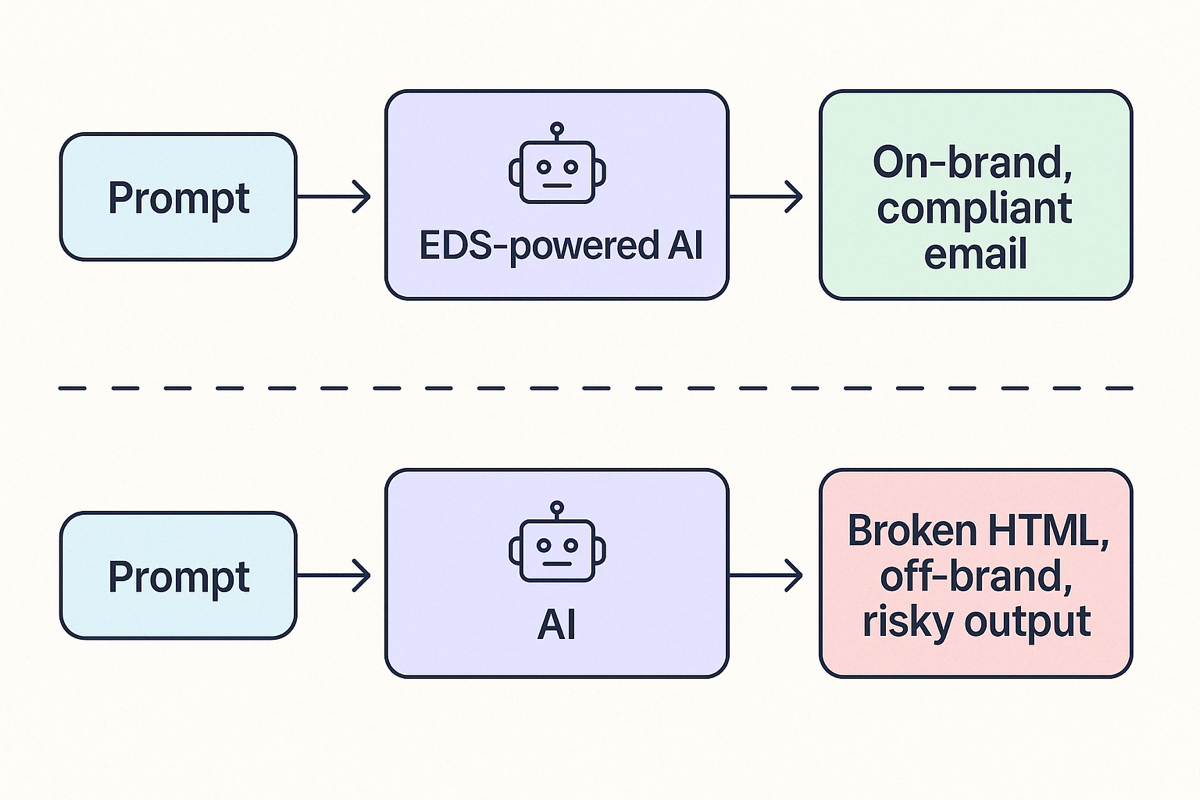Email Design Systems, AI and email generation
Email Design Systems are even more essential in the age of AI
Email Design Systems (EDS) have been key for brands to speed up their email production process. They provide a structured framework that ensures brand consistency, reduces development time, and minimizes quality assurance efforts. With pre-built, tested components, teams can create professional emails more efficiently than ever before.
In the age of AI and content generation, Email Design Systems become essential in the path to automated email creation. They serve as the critical bridge between AI capabilities and brand-compliant outputs, ensuring that even machine-generated content adheres to established guidelines and rendering requirements.
What is an Email Design System?
The exact definition of an Email Design System varies a little between different tools, but the core concept is the same.
Think of an Email Design System as a sophisticated LEGO set with instructions. Users can build what they need using pre-approved pieces that are guaranteed to work correctly across all email clients, compliant with your brand guidelines, accessible.
For example, your EDS may define that a button's text can be changed - but not its color, since your brand dictates that all buttons must be blue. This provides component-level control over what aspects remain locked for brand consistency and which can be modified by end users.
In the email builder, non-technical users can drag and drop these components onto a canvas and customize them within the defined limits. This allows teams to build branded, professional emails without needing to touch code. Since rendering issues, preview quirks, and QA checks are handled during the component design phase, the final build process becomes faster and far less error-prone.
Put simply: an EDS acts as a rulebook and toolkit that governs how your brand's emails are built, what they look like, and what's allowed to change.
The Evolution of AI Capabilities
AI continues to become more impressive, primarily in two ways:
- They are gaining capabilities by being integrated into more and more tools
- The underlying models are getting more intelligent and powerful
The way in which AI is integrated into tools is generally via APIs (Application Programming Interfaces).
APIs are what enable AIs to gain capabilities such as browsing the internet, executing code etc.
These interfaces are designed for machine-to-machine interaction and are the optimal way to integrate AI into third-party tools.
Email Design Systems: The Natural API for AI Email Creation
We have already seen some impact of AI on email creation. Many email building tools have added some AI capabilities. So far this has mostly been in the form of 'alternative text' smart suggestions for individual fields / subject lines, or translations.
The natural evolution in the email creation process is to go from a prompt to a fully built, personalized, compliant, client-compatible, ready-to-send email.
Imagine requesting "a promotional email featuring our new summer collection with a 20% discount code" and having AI instantly assemble on-brand components that follow your approval workflows.
But how will this be achieved?
Why generating HTML isn't enough
The first instinct is to have an AI generate your email's entire HTML code. While language models are good at generating code in general, email development poses unique challenges:
- It's not just about generating valid HTML, it's about generating markup that renders consistently across dozens of email clients and devices
- Email development requires specialized knowledge of client-specific workarounds
- What worked in a given client yesterday is not guaranteed to work today
A typical workflow includes testing your email on a variety of email clients, generally using screenshot tools like Litmus or Email on Acid. With the advent of AI, quality assurance itself can theoretically be automated - AI models could interpret screenshots and flag rendering issues across different clients, potentially eliminating manual review.
There are practical ways of improving this process, such as having the AI generate MJML instead of HTML. MJML simplifies email development with a responsive framework that handles many cross-client compatibility issues automatically. Additionally, the code needed in MJML is typically more concise, which works better with AI models' context size limitations.
However, even if AI could consistently generate functional email HTML code, several critical issues remain:
- Brand consistency and design is lost - Unless specifically guided, AI can't know how your brand's design and style should be applied
- Compliance is at risk - an AI won't know to include the very specific legal disclaimers that may be required for your brand, or even things like unsubscribe links
- Accessibility - Essential accessibility features might be missed without explicit direction
It's not feasible that users would prompt an AI with all this context every time they want to create an email.
This is precisely where the Email Design System becomes invaluable.
When it comes to email generation, the Email Design System should be seen as the API of your email production process - it is the structured interface through which humans or AI agents can build emails according to your brand's rules.
In EmailShepherd, this is precisely what an Email Design System is.

Building an AI-Ready Email Design System
Fortunately, the main principles for building a good EDS for human use apply equally when building one for AI consumption.
You want to ensure your EDS is as locked down as possible while still allowing for the flexibility required to build the emails your audience wants to receive.
This means carefully deciding which aspects of elements can be customized (e.g. headline text, product image) and which should remain fixed (background color, font style). From a technical perspective, this requires implementing strict data validation, providing clear default values, and establishing fallback behaviors when inputs don't meet expectations.
But there are a couple of areas where you need to pay extra attention when building your EDS for AI use:
1. Naming Conventions
Naming conventions become absolutely essential when building for AI integration. While good naming helps human users, it's crucial for effective AI utilization.
The names you choose become part of your prompt. An AI cannot intuitively understand what Component6 represents, but it immediately grasps the purpose of PromotionalHeader_DarkBackground.
| Bad naming | Good naming |
|---|---|
Component6 | PromotionalHeader_DarkBackground |
TextBlock3 | LegalDisclaimer |
img_4 | HeroImage |
This naming principle extends beyond just components - it applies to all resources that an AI might access, such as:
- Components
- Component fields
- Personalization tags
- Images
Practical Example: Field Naming Matters
Consider the difference between calling a field text versus title in your component. A title is much more specific than generic text. A title implies concise, attention-grabbing content, while 'text' could represent anything from a single line to multiple paragraphs.
Human users benefit from visual context in the email builder interface. They can see where the content appears and how it's formatted.
An AI, however, relies primarily on the field name itself:
- A field named
textmight prompt the AI to generate several paragraphs - A field named
titlesignals the need for concise, impactful content
2. Avoid 'unwritten rules'
When teams work together over time, they develop shortcuts and implicit knowledge. Perhaps there's a component in your design system that everyone knows not to use because it's outdated, but it hasn't been removed yet. Or maybe certain components should only be used in specific campaign types.
An AI cannot access this tribal knowledge. It will use any component available in your system unless explicitly told otherwise. This makes maintaining a clean, design system even more important when working with AI.
The Future of Email Design Systems and AI
As AI capabilities continue to evolve, Email Design Systems will become even more crucial. The brands that invest in well-structured EDS today will be well positioned to take full advantage of AI content generation.
See it in action
Watch how in EmailShepherd you can generate an entire email from a prompt, using AI that is powered by your own Email Design System:
If you're interested in learning about how EmailShepherd can speed up your email production process, book a demo.
